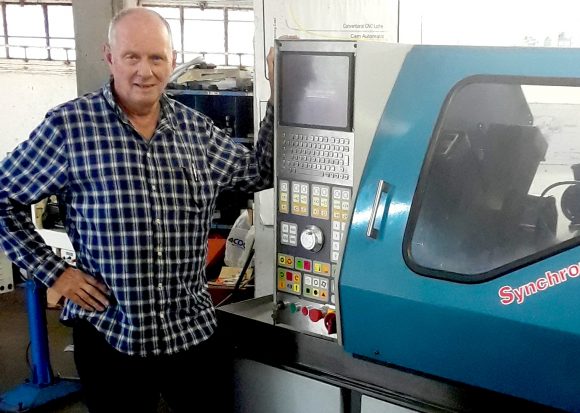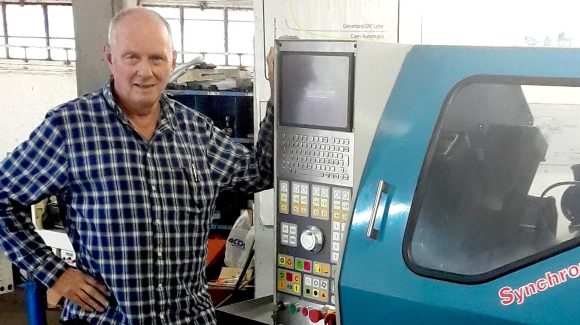On today’s show we’re discussing the machining business in South Africa. Our guest is Peter Frow. Peter has been immersed in the machining business and has also been a participant in the social change of South Africa over the last 50 years.
While so many of his countrymen emigrated, Peter stayed and has recently started a business building a new machine tool in South Africa called FAS Machine Tools.
Scroll down to listen to the podcast. Or listen on your phone on your favorite app or Apple Podcasts and Google Podcasts.


Main Points
Peter talks about his businesses, Renfield Machine Tools, which he started in 1991, and his new company, FAS Machine Tools. Renfield Machine Tools reconditions used cam screw machines and turnkeys them, while FAS Machine Tools builds new machines. (3:40)
Peter says FAS Machine Tools builds a machine in South Africa that has the fast cycle times of a cam screw machine and the user-friendliness of a CNC lathe. He says his machine costs half the money one would likely pay for a comparable machine. Peter describes his machine as similar to a Swiss style machine but with a fixed headstock. It has an 8-station turret that moves on 2 axes, a dedicated turning slide that moves on 2 axes, a dedicated forming slide and a dedicated parting slide. The machine’s design allows for tools to work simultaneously on a workpiece, which gets cycle times down. (5:25)
Peter discusses what it’s like being 75 years old and starting a new company. He doesn’t worry about his age. (8:00)
Peter talks about his background in the machining industry. His father was an engineer at a power utility company in South Africa. Peter received a degree in mechanical engineering and for seven years worked for the same power utility company where his father had worked. In his late 20s he changed careers and went back to his hometown of Durbin. Once there, he joined his father’s screw machine shop. It was supposed to be a temporary gig, but he ended up staying and building up the company over the next nine years, from 1973 to 1982. (9:15)
Peter describes the history of Apartheid in South Africa. He says country consists of essentially four racial groups: black, white, Indian, and those of mixed racial heritage, which South Africans call “colored.” White South Africans are descended either from Dutch colonists (Afrikaners) or the English. In 1948, the Nationalist Party, supported by the Afrikaners, came to power and instituted the Apartheid, separating the country’s racial groups into different geographical areas. The whites, who represented only 20% of the population, controlled the majority of the land. Despite economic sanctions, the unjust situation lasted 40 years. In the late 1980s, F.W. de Klerk was elected Prime Minister. He eventually released political prisoners such as Nelson Mandela, allowed political parties that had been prohibited, and embarked on the process of negotiating a new constitution, which came to fruition with the 1994 Election. (13:50)
Peter talks about his work as church leader and how he worked to bring reconciliation in South Africa in both a religious and political context from 1983-1990. (18:30)
Peter talks about many whites leaving South Africa for fear of what would happen when Apartheid ended. He says he and his wife never considered leaving. He says he likes the complexity and colorfulness of the country. Peter says he enjoys the variety of people in South Africa, and sees a kinship with America in its diversity. Peter’s son lives in the US and holds dual citizenship. (21:20)
 Peter says many South Africans still want to leave the country, most of them white people. He says this is partly because the economy has had a lot of tough times, much of which stemmed from political corruption. He says the country at one point was over 20% white and now it is around 9%. He says that though unemployment is high, there are strong affirmative action programs in place that have helped to level the playing field for black South Africans. (23:40)
Peter says many South Africans still want to leave the country, most of them white people. He says this is partly because the economy has had a lot of tough times, much of which stemmed from political corruption. He says the country at one point was over 20% white and now it is around 9%. He says that though unemployment is high, there are strong affirmative action programs in place that have helped to level the playing field for black South Africans. (23:40)
Peter says the rise in the price of precious metals has helped South Africa’s economy. He says a big part of the economy is based on mining, specifically gold and platinum. (26:30)
Peter says there are a lot of black people and mixed race people working in machining in South Africa, but there still aren’t many who own machining companies. However, he says things are changing. (29:25)
Peter says South Africa continues to suffer from significant disparities in income and living standards. The rich people live in modern cities, while others live in rural areas in mud huts, carrying water on their heads. However, he says the poverty in South Africa is not as extreme as places like India and that people from all over Africa travel to South Africa to find work. (30:10)
Peter says engineering is a relatively popular career choice in South Africa, but the country has the same problems as the US when it comes to finding skilled people to work in machine shops. He says one of the reasons he created his new CNC lathe is because it’s hard to find skilled labor to work on cam machines. (31:40)
Peter discusses where he lives. His home is in a suburban area on the edge of a wildlife reserve so he gets to see a lot of bush bucks and wild pigs nearby. He says his home is just 25 minutes from a small game park, but jokes that there are no lions roaming down the street. (33:00)
Peter talks about wages of a factory worker in South Africa. He says it is not accurate to compare salaries to those in other countries because the cost of living in South Africa is relatively low. He says the standard of living for a person working in the machining industry is similar to what it would be in the US. (34:15)
Peter says one of the most interesting things he has learned in the last week was reading about the new peace accord between Israel and the United Arab Emirates (UAE). (35:20)
Question: What country do you think builds the best machine tools?
Podcast: Play in new window | Download

